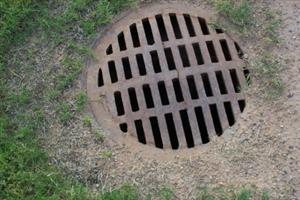| Complexity level: | 6 |
| Project cost ($): | 30 |
| Time required: | 1 day to prepare, 1 hour for experiment |
| Material availability: | May be obtained from a hardware store |
| Safety concerns: | None |
Hypothesis
The dome shaped drain cover will be less likely to become clogged by debris.
Overview
Drain hole cover
During heavy rain, water accumulates on the surface of roofs, roads and turfs. All this water needs to be channeled into proper drains in order for the water to find its way into the larger drainage system. If this is not achieved quickly or the passage for water to escape is blocked, water will accumulate and floods result.
During heavy rains, when the water levels rise, water flows into drain holes and fill up the larger storm drains underneath. However, flowing rain water carries with it, debris such as dried leaves, grass, paper, plastic wrappers into these very same drain holes. Drain hole covers are used to prevent debris from entering the holes and causing blockages. These drain holes trap larger debris, while allowing water to flow through gaps or holes into the storm drains. These covers need to be cleared regularly otherwise, eventually the surface of the drain hole covers will be completed blocked by debris.
Scientific Terms
Materials
The materials required for the science fair project:
- A 2 meter long gutter with a drain hole on one side
- 2 stools
- 2 bricks
- A pail of water mixed with dried leaves
- A pail of water mixed with grass
- A pail of water mixed with soil
- A pail of water mixed with plastic wrappers
- A roll of wire mesh
- A small bowl
- A pair of scissors
- An empty pail
Procedure
1. For this science fair project, the independent variables are the type of debris used (i.e. dried leaves, grass, soil and plastic wrappers) and the type of drain hole covers used i.e. flat or dome shaped. The dependent variable is if the drain hole cover will be clogged. This is determined by pouring a pail of water that has been mixed with debris into the gutter and observing whether clogging takes place. The constants (control variables) are the size (diameters) of the drain hole covers, the amount of water mixed with debris and the size of the gutter.
2. The wire mesh is cut into a shape and size slightly bigger than that of the drain hole. It is used as the flat gutter cover. A 2nd piece of wire mesh is cut and placed over a small bowl to form a dome shaped drain hole cover.
3. The gutter is placed on the 2 stools. An empty pail is placed under the drain hole of the gutter. The opposite end of the gutter is raised by placing 2 bricks underneath it. This will ensure that water flows towards the side with the drain hole.
4. The flat drain cover is placed over the drain hole and the pail of water with dried leaves is poured down the raised side of the gutter. It is observed whether any clogging takes place in the drain hole and these observations are recorded in the table below.
5. The drain cover is cleared of any debris and Procedure 4 is repeated using the pail containing water with grass, soil and plastic wrappers. Observations are recorded in the table below.
6. Procedures 4 and 5 are repeated with the dome shaped drain cover and observations are recorded in the table below.
Results
The results show that the raised dome shape drain cover was more effective in stopping the debris along its perimeter while the raised center of the dome was unblocked for water to flow through. However, the flat drain cover was completely clogged by larger debris . Only the water mixed with soil was able to flow through the flat drain cover without clogging.
| Drain cover type | Comparing flat and dome shaped drain cover | |||
| Dried Leaves | Grass | Soil | Plastic wrapper | |
| Flat | X | X | Y | X |
| Dome | Y | Y | Y | Y |
Conclusion
The hypothesis that a flat drain coverS will more easily become clogged by debris is correct.
Drain hole covers are also found in kitchen sinks, bathrooms and roof gutters. They are there to prevent any large debris or rubbish from entering the plumbing pipes and causing blockages. Even though the surface of the drain hole cover needs regular cleaning to remove the debris, this is much easier to do compared to clearing blockages that occur inside the plumbing.
Also consider
Try to repeat this science fair project using different type of debris like paper, rocks, broken branches or sand.
The experiment can also be repeated using cone shaped, pyramid shaped or box shaped drain hole covers.
References
How to cover and open a drain hole - http://www.doityourself.com/stry/how-to-cover-an-open-drain-hole
Blocked drain and blocked drainage - http://www.articlesbase.com/home-improvement-articles/blocked-drains-and-blocked-drainage-394320.html

